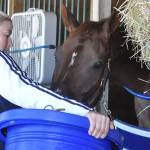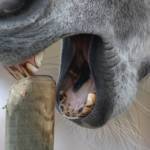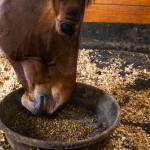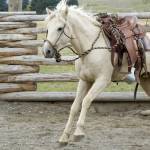Medieval Madness: Jousting Then and Now

Knights clad in suits of armor atop galloping steeds are a potent, ubiquitous image of medieval times. Wielding lance and shield, armored knights and horses were fleeting tanks of flesh and bone and far more agile than foot soldiers in times of war. Despite the romantic images of them as the epitome of chivalry or of their initiation ceremony as the height of pomp and splendor, knights were first and foremost warriors, simple fighting men.
Knights honed their battling skills in one of two ways, in actual warfare or in practice off the battlefield. In times of peace, tournaments or mock battles were staged with twofold intent, for the delight of spectators and for the sharpening of skirmishing tactics. Tournaments were considered credible practice grounds until the status of knights in actual war declined. With the advent of gunpowder, the skill of unhorsing a rider from his steed became obsolete. The tournament field then became a place of sport, an outlet for knights to display their skill. Kings and other aristocracy begrudgingly tolerated the new sport, but cited the gatherings as sparks that might ignite civil disturbances. As sportsmen, however, the zeal of nobility for competition often overshadowed any hint of statesmanship.
Set in mainland Europe, the first tournaments usually featured two teams of knights that fought under established conditions. The knights would often battle for a prescribed time using preordained weaponry, typically swords and lances. The brawls, referred to as melees, did not pit one knight against another in individual combat. Melee fighting was undoubtedly more frenzied and crude than one-on-one battle.
Tournaments featured both the savory and unsavory aspects of war, including camaraderie, enthusiasm, gallantry, stealth, bloodshed, and occasionally death. In time, tournament organizers imposed more concrete rules which significantly reduced fatalities. By the beginning of the thirteenth century, the first jousts were documented.
Some historians believe jousts were started as a reaction against the fortuity and brute force that decided the fate of those engaged in melees. Jousts did not replace tournaments, but rather were staged as sideline exercises. In jousting, a warhorse was asked to gallop head-on towards another warhorse, while both carried knights armed with lances. This maneuver required refined horsemanship skills, including a secure seat, as the lances were about twelve feet long and three inches in diameter. As the popularity of jousts rose, scoring was introduced, with the object being to break three lances squarely on the opponent’s armor or shield while simultaneously averting a counterblow. Unhorsing an opponent meant instantaneous victory whether the spear splintered or not.
In jousting, skill became paramount and endurance less important. The joust was effective in determining which of two knights was defter in battle. Among the knights, jousts were the more vainglorious ventures, as a personal victory in a joust was far more impressive than being part of a winning melee team.
Until the mid-thirteenth century, the sword was more decorative than practical, as mounted sword fighting was unheard of. When knights wished to draw out the jousting competitions beyond the breaking of three lances, swordplay on foot followed. When one of the two knights became unhorsed, the other would dismount and ground jousting would begin using blunt-edged weapons. If neither of the knights was unhorsed, both knights would dismount and commence fighting. Over the years, this element of the joust began to resemble a crude fencing match and actually became the most difficult portion of the competition.
Swinging the heavy and sometimes awkward sword repeatedly into resilient armor was taxing for the knights and often sheer stamina determined the victor. By the early fourteenth century, the joust was a staple of tournaments, often obscuring the more traditional melee.
In the late fifteenth century, jousts were sometimes conducted “at the tilt,” meaning a wooden barrier separated the warriors. Use of the barrier was implemented because accidental or intentional collisions were potentially perilous to horses and knights, regardless of being clad in armor.
Despite their great popularity, tournaments began to fade in significance as economic reforms and changes in social order swept across Europe. By the end of the 1500s, other forms of entertainment had replaced the colorful spectacle of armed battle on horseback.
Resurgence of Sorts
One offshoot of jousting is the “ring tournament.” Introduced in Maryland in the mid-1600s, the ring tournament may be the consummate test of equestrian eye-hand coordination. In this event, three small rings, the largest with a diameter of 1 3/4” and the smallest with a diameter of 1/4”, are suspended from arches spaced equidistantly through an 80- to 100-yard course. Ring size is decided based on rider experience with more novice participants spearing the larger rings. Using a fine tipped lance, riders gallop full-tilt through the course recovering as many rings as possible in eight seconds.
Points are awarded according to the number of rings successfully skewered. Jousting became the official state sport of Maryland in 1962 and is played throughout not only Maryland but also surrounding states.
Nearly five hundred years following the decline of tournaments, resurgence in the popularity of jousting and all things Renaissance began. Renaissance festivals have mushroomed throughout the United States, fueling the rebirth of full-contact jousting. Bedecked in authentic-appearing suits of armor and brandishing lances and blunted swords, modern-day knights have revived this time-honored sport. The content of these shows is often outlined, and a certain degree of trickery is inherent with the winner usually determined prior to the start of the joust. Improvisational skills are refined with each performance, however, as some variables are beyond the control of the production team or the scriptwriters.
Various breeds of horses are used by the knights of the twenty-first century. Any mount chosen as a festival steed must be sturdy enough to carry the weight of his armored rider. He must also possess the temperament and training to mix with other pennant-bedecked horses and to accept the noisy accolades of spectators expressing their enthusiasm for this ancient sport.








